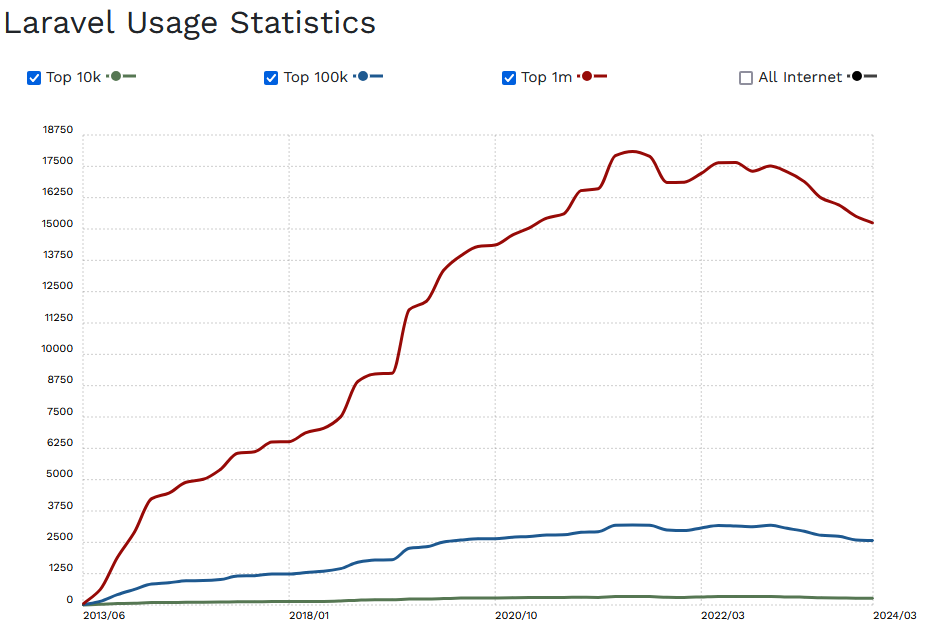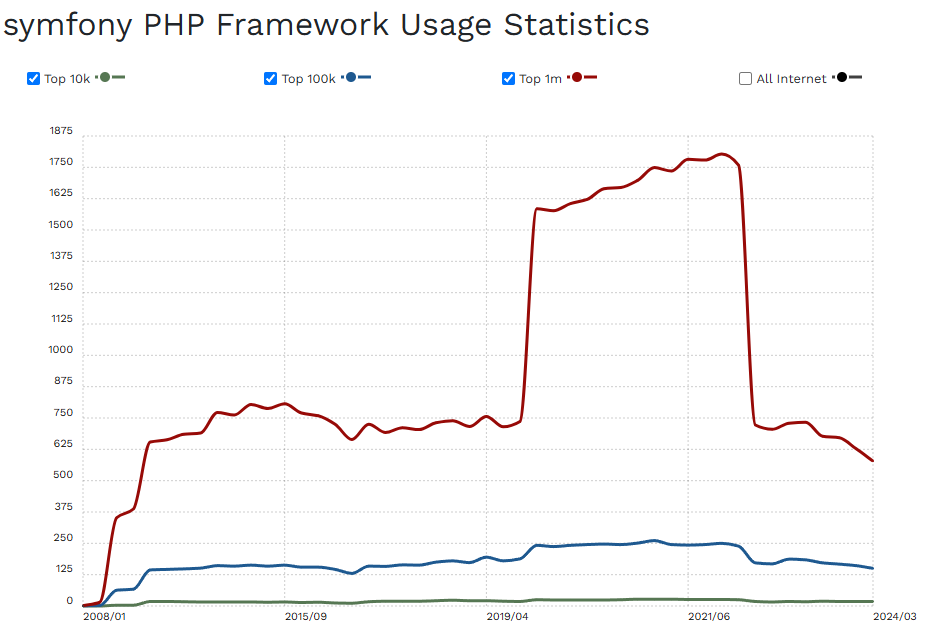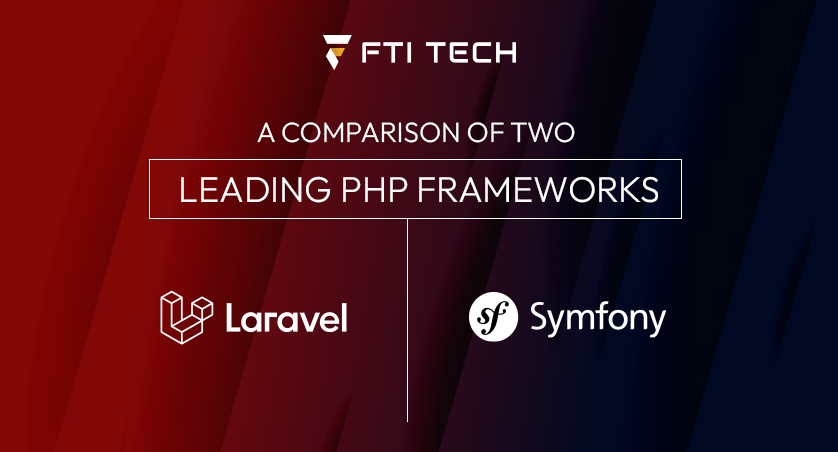Laravel vs Symfony: A Comparison of Two Leading PHP Frameworks
Laravel and Symfony are the most popular PHP frameworks for web development. If the popularity is compared, both have equal support from the developer community. So, how do you decide which one of Laravel and Symfony is best for your web app development project?
Laravel is ideal for small to medium-sized enterprises (SMEs) due to its ease of use and rapid development capabilities, while Symfony is more suitable for large-scale, enterprise-level projects requiring a highly customizable and scalable architecture.
This article aims to help you understand key differences and features of Laravel and Symfony. By the end, you’ll be able to make an informed decision that aligns with your project’s requirements. Let’s first understand them independently.
Laravel vs. Symfony: An Overview
When comparing Laravel vs. Symfony, you need first to consider how these frameworks differ on a fundamental level and their core features.
What is Laravel?
Laravel is an open-source PHP framework which is popular for simplifying web application development. Taylor Otwell developed Laravel using Symfony components, which builds a solid foundation for robust and scalable applications. It adheres to the Model-View-Controller (MVC) architectural pattern and offers the benefits of server-side handling, routing, HTML authentication, templating, and more.
Due to server-side capabilities, building a web app with Laravel and pre-defined architectures is easier. Laravel also supports customized backend logic, making it suitable for building everything from simple web portals to complex full-stack applications.
Core Features of Laravel
Laravel’s extensive feature set is a robust framework for building modern web applications. Below are some of its core features:
- Eloquent ORM(Object-Relational Mapper) streamlines working with database. Each database table has a corresponding “Model” that interacts with it. Eloquent allows developers to work with PHP syntax instead of complex SQL queries.
- Artisan CLI is the command-line interface included with Laravel. It provides helpful commands for developing Laravel applications, such as database migrations, task scheduling, and custom command creation. This tool is a time-saver as it automates repetitive tasks.
- Blade Templating Engine is Laravel’s lightweight templating engine. It allows plain PHP code in views and includes features like template inheritance and sections to organize your application’s layout.
- Routing in Laravel provides a simple and elegant mechanism for quickly creating expressive API and web routes. Routes are defined in the routes file and mapped to controllers or Closure-based functions.
- Middleware provides a convenient mechanism for filtering HTTP requests entering your application. For example, Laravel includes built-in authentication middleware that restricts access to certain routes. Only authenticated users can access specific parts of the application.
- Laravel task scheduler provides a fluent and expressive way to define command schedules within the Laravel application. This feature uses the `schedule` method to execute recurring tasks, such as sending emails or cleaning up databases, without manual intervention.
- Queues in Laravel provide a unified API for various queue backends. It enables deferred processing of time-consuming tasks such as sending emails and generating reports. This improves application performance and responsiveness while handling background tasks.
What is Symfony?
Symfony is a back-end PHP framework. While it shares the same core language as Laravel, what sets it apart is its extensive library of reusable pre-built components. Symfony itself is a collection of independent, interoperable PHP libraries that can be used individually or together. Created by Fabien Potencier in October 2005, this framework supports scalability and ensures end-user experience with streamlined development.
It works well for large-scale, complex projects that require a high degree of customization and control. Symfony’s component-based approach promotes code organization, maintainability, and builds highly performant applications.
Core Features of Symfony
- MVC Architecture – Symfony uses the Model-View-Controller (MVC) pattern which divides the application into 3 different layers:
- Model (data access layer)
- View (presentation layer)
- Controller (request handling layer)
This division helps web developers to manage application logic, data, and presentation independently. This pattern helps keep the code organized and easy to maintain.
- Reusable Components – Symfony has a big library of reusable components such as the HTTP client, routing, templating, etc. for different projects. You can use these components individually or together. Thus, using Symfony for PHP development makes it faster and easier.
- Bundles – Symfony applications are structured as bundles, making code modular and reusable. This approach facilitates code sharing and project organization.
- Dependency Injection – Symfony uses the dependency injection method a lot. By managing object dependencies, developers can write cleaner and more maintainable code. This practice makes the code easier to test and more adaptable.
- Built-in Tools – Symfony offers various tools for everyday tasks. These include routing, templating, and form handling. These tools streamline development and improve efficiency.
- Community and Documentation – There is a large and active community around Symfony. Plus, there is a lot of helpful documentation. This makes it simpler for developers to find help and resources.
Now that you have an overview of Laravel vs Symfony, let’s discuss their pros and cons before deciding between them.
Pros & Cons of Laravel
Pros
- Laravel PHP framework has simple and readable code, making it easier to write new codes on the framework. This leads to faster development cycles.
- A large and active community of Laravel means easy access to help and extensive resources. Laravel developers can easily find solutions to common problems and challenges.
- Laravel provides many built-in features, including authentication, authorization, routing, caching, and more. You will not need third-party packages so often.
- Tools like Laravel Mix for asset compilation and the Blade templating engine contribute to improved Laravel development process.
- Laravel can be used for projects of any complexity, beginning from small websites and up to large enterprise applications. Its modular architecture and support for microservices make it easy to scale applications as needed.
Cons
- Understanding and effectively using all the features and tools requires a considerable time investment. It necessitates a commitment to learning and practice.
- Laravel’s extensive feature set can lead to higher memory consumption and slower performance compared to more lightweight frameworks.
- Laravel frequently releases updates and new versions which sometimes introduce breaking changes. This requires developers to continuously adapt to the latest changes accordingly.
- For smaller projects, Laravel’s extensive features may lead to unnecessary complexity. In such cases, a more lightweight framework might be a better fit.
Pros & Cons of Symfony
Pros
- Symfony’s component-based architecture allows developers to choose the exact tools needed for a project. This results in highly customized and efficient applications.
- It is known for its speed and scalability. In various performance tests, it often outperforms other PHP frameworks.
- Symfony has extensive documentation, including manuals, tutorials, and API docs. Developers can easily learn and use the framework effectively.
- The third-party bundles and extensions in Symfony have active groups for better assistance.
- Laravel and Drupal are just some PHP projects and frameworks that use some or many of the Symfony components.
Cons
- Symfony’s flexibility and extensive feature set can make learning challenging, especially for beginners. New developers may find it challenging to grasp the framework’s concepts.
- The highly configurable nature of Symfony can lead to increased complexity of development time.
- Symfony requires more boilerplate code, which can make the codebase larger and more complex.
Laravel vs. Symfony: The Differences
When comparing Laravel vs. Symfony, multiple factors need to be considered, like ease of testing or performance and even the architecture of both frameworks. While Laravel is often used for small-scale projects, it is also capable of supporting large web applications. At the same time, Symfony is known for supporting large-scale projects.
So, it becomes important to consider different factors when comparing Laravel and Symfony. Let’s first compare Laravel’s performance.
1.) Laravel vs. Symfony: Performance Comparison
Performance measurement is a significant factor to consider. If we compare loading time of each framework, Laravel sites loads in around 60 milliseconds while Symfony sites load in around 250 milliseconds.
But when we compare Laravel and Symfony in terms of memory usage and processing speed Symfony has the lower memory usage due to its modularity. On the other hand, Laravel has high memory usage due to its integrated features and components.
Overall, Laravel’s user friendly approach and in-build features make it more efficient and provide good performance for smaller to mid-sized projects. Symfony is known for its flexibility and robust architecture. This will lead Symfony to provide better performance in complex, enterprise-level applications.
2.) Laravel vs. Symfony: Core Architecture
Both Laravel and Symfony are built upon the Model-View-Controller (MVC) architectural pattern. However, the way each framework implements MVC has some differences.
Laravel uses a model-view-controller (MVC) architecture at its core. It allows you to improve productivity and split tasks according to a specific model. For example, you can split the team to handle different aspects like frontend, backend, and business logic. The MVC pattern helps you better control the application and enable customizations that engage the audience globally.
Symfony also uses the MVC architecture. It keeps the business logic separate from the presentation layer, which means that if you make changes in the business logic, they do not impact the user experience. On the contrary, Symfony’s MVC architecture allows more accessible updates by separating concerns. So, if you want to update the app, change the view part without affecting the model part. There is an abstract layer between the business logic and view parts, ensuring seamless communication.
3.) Laravel vs. Symfony: Database Support
Laravel supports various database systems. With eloquent ORM and raw SQL, communication between apps and databases is simple. Laravel may support more database systems with new versions and continue facilitating ease of connections with the applications.
On the contrary, Symfony offers more comprehensive support for database systems, including, Drizzle, MySQL, Oracle, PostgreSQL, SAP Sybase, SQL Anywhere, and SQLite. It allows apps to connect easily with the database systems using Doctrine ORM. The separation of concerns makes Symfony special in terms of database support.
It all allows you to separate the object model from the database schema. So, you have more freedom to make changes to database columns without needing to change the entire codebase.
4.) Laravel vs. Symfony: Usage Statistics
If you compare the usage statistics, Laravel has more than 1,150,186 live websites using the framework at its core, while Symfony has more than 24,333 live websites. So, there is no denying that in terms of usage, Laravel has the upper edge over Symfony.

Laravel’s ease of use and developer-friendly features make it highly popular. Compared to Laravel, Symfony has low usage but a strong presence in enterprise and complex application environments.

5.) Laravel vs. Symfony: Which One Scales Better?
Symfony offers better modularity than Laravel, with reusable components that developers can leverage for rapid development. While comparing Laravel vs. Symfony, speed favors Symfony, and modularity is also an advantage. Laravel shines in terms of startup time.
The MVC-based framework allows developers to start, build, and run pre-built apps quickly, reducing market time.
Ultimately, the scalability of a project depends on various factors, including database optimization, caching strategies, and infrastructure. Both Laravel and Symfony can be scaled effectively with the right approach.
6.) Laravel vs. Symfony: Testing Ease!
Laravel has PHP at its core, one of the oldest technologies offering support for several testing tools. This allows developers to create bug-free creations for the users through rigorous testing. It also supports testing automation, ensuring rapid time to market and accurate results. Plus, it offers robust documentation and all the tools you may need to test app environments at different levels.
Symfony, on the other hand, supports tools like PHPUnit, Symfony’s WebTestCase, and Blackfire. These tools make testing apps effortless, and Symfony provides doctrine bundles to create test suites. It allows you to run unit, functional, and integration tests.
Final Thoughts
Being PHP frameworks, comparing Laravel vs. Symfony often reaches a breaking point where you may be confused. For example, Laravel and Symfony are secure enough for developers to create robust web apps. However, Laravel does offer pre-built authentication features, gaining an edge over Symfony. Meanwhile, Laravel has powered apps like Pfizer, BBC, GitLab, Wattpad, and PayZip.
Symfony has the edge when it comes to large-scale projects. Both are scalable and offer extensive support. Choosing the right one becomes a little tricky. Ultimately, choosing between these frameworks will be easier if you can compare Laravel and Symfony usage and align it with your business objectives.



